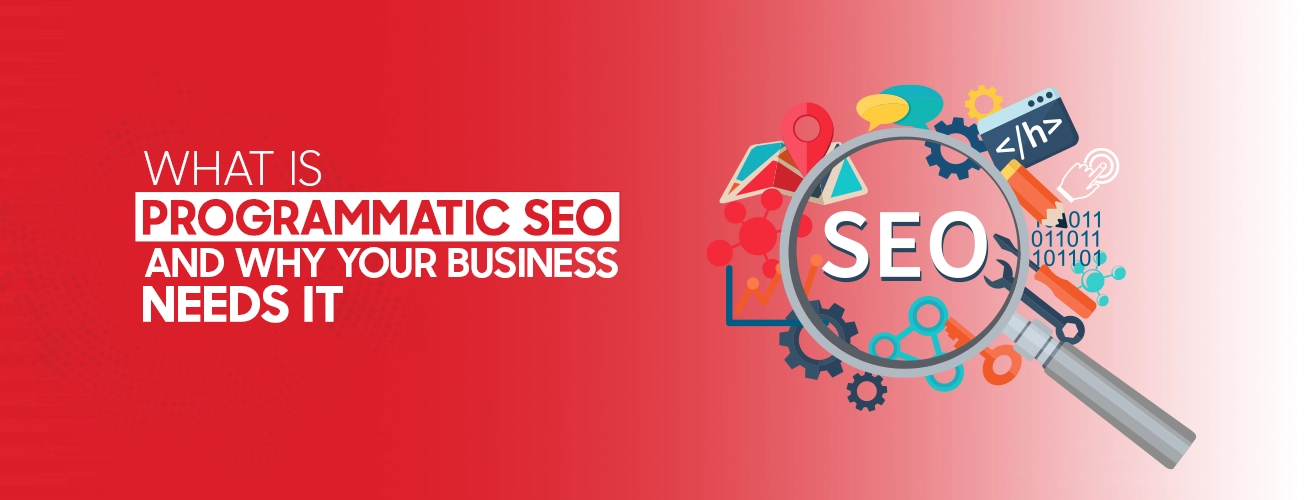What Is Programmatic SEO and Why Your Business Needs It?
Do you know there are over 26 million eCommerce stores online? Yes, there are, you can imagine how competitive the eCommerce world is becoming. The Pandemic caused unprecedented expansion in the online market space, and this expansion is ongoing at an incredible pace. This makes it harder to stand out in this over-crowded market, the search engines show thousands of web pages against hyper-specific search queries. It is also a fact that more than 91% of Google searchers do not bother to scroll down and click on the second page. On top of that, 50% of internet searchers don’t even bother to scroll down the top three search results on SERPs.
You may be thinking about how one can get prominence in this market, and how one can get a top three position in a search engine result page. One sure answer is Search Engine Optimization. SEO can help you improve visibility, but traditional means of optimizing web content no longer seem effective. The fierce competition is rendering SEO campaigns based on manual methods quite unproductive. Digital marketing firms need to do something to make SEO marketing efforts align with modern trends and requirements. One answer is Programmatic SEO. This new and innovative approach to SEO is gaining traction due to its effectiveness, cost-efficiency, and other benefits. If you are interested in remaining ahead of the curve, which you would be aspiring to, you need to adopt this approach. This blog serves this purpose exclusively.
In this article, we are going to discuss everything you need to know to launch a successful programmatic SEO marketing drive. The benefits of this innovative Search Engine Optimization approach, potential drawbacks, and some examples that you can take inspiration from, we are going to cover everything for you.
Ready to jump in? Let’s dive in!
Let’s begin by discussing programmatic SEO in depth.
What is Programmatic SEO?
We all know what standard SEO means, It is a marketing technique that helps a website or store rank higher on search engines such as Google, Bing, Yahoo, etc. Various kinds of activities are performed to accomplish this end, such as keyword optimization, off-site tasks such as link-building, social media campaigns, etc.
Unlike standard SEO, Programmatic SEO is an innovative and data-driven approach. The manual tasks commonly done in normal SEO are replaced with automated tools and AI-enabled processes to execute SEO for specific pages. Machine learning and other advanced technologies help marketers publish a large number of landing pages simultaneously.
In this type of SEO, digital marketing agencies deploy advanced analytics and tracking tools to get real-time insights. These insights are then used to generate very targeted content, enabling websites to appear higher against hyper-specific search queries.
For instance, Zapier has deployed this SEO technique quite successfully. It has generated individual programmatic SEO pages for each app, meeting the specific needs of users and earning revenue from enhanced website traffic. Similarly, many IT firms are working on this particular SEO type to improve their SERP ranking.
Having discussed the basics of programmatic SEO, now it is time to explain why businesses need to implement it.
What are the benefits of programmatic SEO for businesses?
Here are some benefits that businesses, no matter how small or large, can reap from implementing this SEO approach.
#01: Enhanced Scalability and Efficiency:
Your business is growing, and you are struggling to scale your SEO efforts to meet the expanding needs. Programmatic SEO helps you do it almost effortlessly. No matter how fast your business is growing or how many web pages you need to optimize, this approach will let you continue to rank your website under all circumstances.
You can create and streamline landing pages at scale, allowing you to remain in the top three positions on SERPs. On top of that, this also allows you to simplify link-building efforts as you would be able to automate relation management and outreach drives.
#02: Cost-Efficient and Highly Effective SEO Marketing Drives:
Though programmatic SEO could have some costs initially, in the long run, it becomes very cost-effective. You can automate the bulk of SEO activities, allowing you to save your resources and manpower. The freed-up resources can thus be employed for other tasks, enabling businesses to improve productivity and resource efficiency.
#03: Personalized Content:
Personalized content is another major benefit of using this SEO approach. Unlike traditional SEO, which is more or less like shooting in the dark, programmatic SEO allows you to generate content that aligns perfectly with the target audience. You can change content as per demographics, regions, and other factors, making your website a magnet, attracting visitors, and earning huge revenue in the end.
#04: Improved User Engagement and Experience:
With the help of this innovative and adaptive SEO technique, you can offer a seamless user experience and engagement. Various tools available allow you to optimize website speed, deliver a mobile-responsive design, and enhance overall usability.
Besides these, you can also generate content that mirrors the needs and values of the target audience. All of these SEO activities lead to a better user experience and improved customer satisfaction. In particular, if you implement programmatic SEO on WordPress, this can enhance your website’s ranking on SERPs significantly.
#05: Valuable Insights and Data-Driven SEO:
The widespread use of data and algorithms in this form of SEO allows digital marketing firms to gain valuable insights regarding the performance of websites. You can track, monitor, and analyze the outcomes of SEO campaigns and come up with informed decisions concerning which SEO strategy is working and which is not. You can thus make changes to them, adjusting drives and doubling down on keywords or topics that are proving effective in meeting Key Performance Indicators, or KPIs.
We have seen, at least theoretically, that programmatic SEO can work wonders, but are there some examples in the real world that can prove our point? The answer is a big yes! Some real-life examples show how effective this SEO type can be when it comes to achieving improved ranking on search engine result pages.
Let’s discuss some of them.
Real-Life Examples of Successful Programmatic SEO Drives:
Here are some examples that inspire you:
Booking.com:
This travel company has successfully employed programmatic SEO to launch thousands of custom landing pages targeting various cities and travel services. As a result, Booking. com ranks consistently higher on search engine result pages.
Zapier:
Zapier is another success story. This firm has generated individual programmatic SEO pages for each app, meeting specific users’ needs and attracting massive website traffic. It also focuses on inserting dynamic data instead of written content, which helps it gain prominence whenever a specific query is made.
Tripadvisor:
Tripadvisor can also cited as a front-runner travel agency that has successfully exploited the potential of programmatic SEO to ensure improved ranking. It has curated thousands of pages, each representing a specific query the visitor makes and showing everything tourists need to know, including accommodation, food, etc.
As a result, whenever a query is made, such as “Best Thing to Do in Paris,” Tripadvisor ranks in the higher position on the result pages. This has made this travel agency the go-to platform for seeking travel recommendations.
Yelp:
Yelp is known for helping users find local services and businesses. This firm has also used Programmatic SEO to its advantage, creating thousands of specific pages for cities, businesses, and services. Yelp has been able to attract millions of visitors every month, earning massive revenue from website traffic.
These are some of the many examples that show how effective this SEO approach can be for boosting an online presence. In this view, you should learn some basics of programmatic SEO so that you can better exploit this scalable approach to meet your KPIs.
Now, we look at the steps involved in launching this SEO campaign.
How to Get Started with Programmatic SEO Drives:
Let’s discuss each step involved in creating programmatic SEO pages in detail.
Step #01: Keyword Search:
The first step in programmatic search engine optimization is finding the relevant keywords that can be scaled.
You need to find keywords that have high search volume to attract website traffic, but it should not be so competitive that you may find it difficult to rank them. You can use various tools to find relevant keywords, such as Google Keyword Planner, SEMrush, and Ahrefs, the like.
Here are some important points that you need to know:
- First, you need to find the Head Terms. They are broad categories that represent the overall offering your business offers. You can find by pinpointing the primary products and services, for instance, if you deal in hardware products, the head terms would be computers, workstations, desktops, etc. Head terms can also be phrases that are associated with your niche or domain.
- Second, after finalizing the head terms, the next step is to find modifiers. Modifiers are specific keywords or phrases that add context or specificity to your heading terms. To find modifiers, you can brainstorm various variations or descriptions related to head terms, and analyze search engine autocomplete suggestions.
For instance, if your head terms are computers, desktops, or laptops, potential modifiers would be affordable, budget-friendly, and the like.
You can use keyword tools to analyze the search volume and competitiveness of your modifiers.
Step #02: Checking Search Intent:
Once you finalize the head terms and modifiers, you can use them appropriately to write compelling content that reflects the keyword-matching user intent. You must know the user intent behind every keyword or phrase, you need to know whether users are looking for a product, service, information, or something else. Writing content reflecting search intent is critical to boost engagement rates and attract the right audience.
Step #03: Conducting Competitive Analysis at Scale:
Knowing the strategies that your competitors are employing is also a crucial part of programmatic search engine optimization.
You need to undertake these steps to outflank your competitors:
- First, you need to know who your competitors are in the market and which firm is a top-ranking website for your selected keywords.
- Second, analyze comprehensively all SEO techniques they are using, such as content optimization, on-page optimization, backlink profiles, and more. You must know which strategy is working to rank them in the higher positions on SERPs.
- Third, you can use various tools, such as Ahrefs, Moz, and SEMrush, to collect data from your competitors. You can gain insights on their keyword ranking, domain authority, and the like.
- Lastly, now you can analyze the insights and explore areas where you can exert yourself and capitalize on underserved areas within your domain, niche, or industry.
Step#04: Building Your Landing Pages:
Now it is time to use all keywords, user intent, and data for building landing pages. Landing pages are considered key to converting visitors into leads and actual buyers. You can create landing pages by following the steps:
- First, create page templates for various categories such as articles, product pages, and more. These template pages must reflect the best SEO practices such as content curation, meta descriptions, and optimized title tags.
- Second, use personalization functions to customize landing pages so that they can better address the specific needs of the target audience.
- Third, use content management systems and other automation tools to populate these pages with data, allowing you to create unique SEO pages at scale.
- Lastly, monitor and measure the performance of these programmatic SEO pages against various performance indicators such as bounce rate, conversion rate, time on page, etc.
#05: Publishing Content on Your Website:
Finally, the last step in programmatic search engine optimization is to publish all content on your website. You need to make sure that all landing pages are linked within your site structure, it will allow you to deliver a uniform and consistent user experience. Furthermore, this will also help search engines crawl and index your web pages, allowing you to win a better position on search engine result pages.
Last but not least, you need to continue to monitor the performance of your landing pages. You had better use analytics to gain insights for redesigning SEO strategies for better outcomes such as higher traffic, improved ranking, and better customer engagement.
Undoubtedly programmatic SEO can do wonders, but you should also know that it is not always rainbows and butterflies. Everything has a flipside, and so has programmatic search engine optimization. You need to know these drawbacks so that you can better employ this technique to boost your online presence.
Shortcomings of Programmatic SEO:
Here are some common problems that you need to know:
Duplicate Content:
Duplicate content is one of the most serious handicaps when you run your website on programmatic SEO. For instance, if you are running a location-based website and use this search engine optimization to populate pages for each city, say in the Netherlands, you end up having thousands of pages. There is very likelihood that these pages would have repetitive content. Since Google analyzes the uniqueness of pages to rank websites, the repetition and duplication of content lead to penalization and lower ranking.
To resolve this issue, you can use various tools to rewrite the sentences. For instance, ChatGPT3, SEOmatic, and Smodin.io are some of the tools available to spin sentences to avoid penalization from Google.
Keyword Cannibalization:
This is also a major problem associated with this SEO approach. Keyword cannibalization occurs when you use one keyword to create multiple pages. This ends up having various keyword variations with the same meaning. Google dislikes cannibalization as well, it can lead to penalization and a downgrade in ranking.
Slow Google Indexing:
Google indexing means that Google crawlers have visited your website. Google indexing is important because it makes your website available to readers on Search Engine Result Pages. But sometimes, crawlers take time to visit the website, which can cause serious problems. If you are using programmatic search engine optimization, this slow Google indexing can be due to the following reasons:
-
Multiple URLs
Employing programmatic SEO results in 1000 pages, creating multiple URLs. This makes it harder to crawl all pages, causing slow Google indexing.
-
Low Domain Authority:
Websites optimized through this SEO approach usually have low domain authority. Some even have less than 30 DA scores. This low DA score causes doubts, and crawlers don’t visit on time because they don’t trust your website.
To resolve these issues, you can use the Google Indexing API and use Foudroyer. Froudroyer is a no-code software that counts on the Google Indexing API to index your website within 24 hours.
These are some problems you need to know about. Having said that programmatic SEO is fast becoming a preferred choice for digital marketing firms, you cannot ignore technical SEO. Technical SEO is still important because it helps you build your ranking on a sustainable basis, besides improving the user experience and boosting sales and revenue.
Final Words:
The world of eCommerce is becoming fiercely competitive. You cannot rely on traditional and time-consuming digital marketing techniques to improve your ranking and establish an online presence. You need to explore new and innovative methods to complement your marketing efforts. Programmatic SEO is one such approach. It is gaining traction among digital marketers due to its effectiveness, targeted content, improved user experience, invaluable insights, and data-driven decisions. You need to follow some simple steps to implement this. There is no denying that in this age of a digital-first business environment, you must explore the option of AI-driven techniques, but this does not mean that you ignore technical SEO. Both technical SEO, which emphasizes manual optimization, and programmatic search engine optimization, which relies on automation, must be implemented simultaneously. You can boost ROI on digital marketing drives by exploiting the potential of both of these SEO approaches.
Thanks for your reading. We love to receive your feedback to improve our write-ups.




